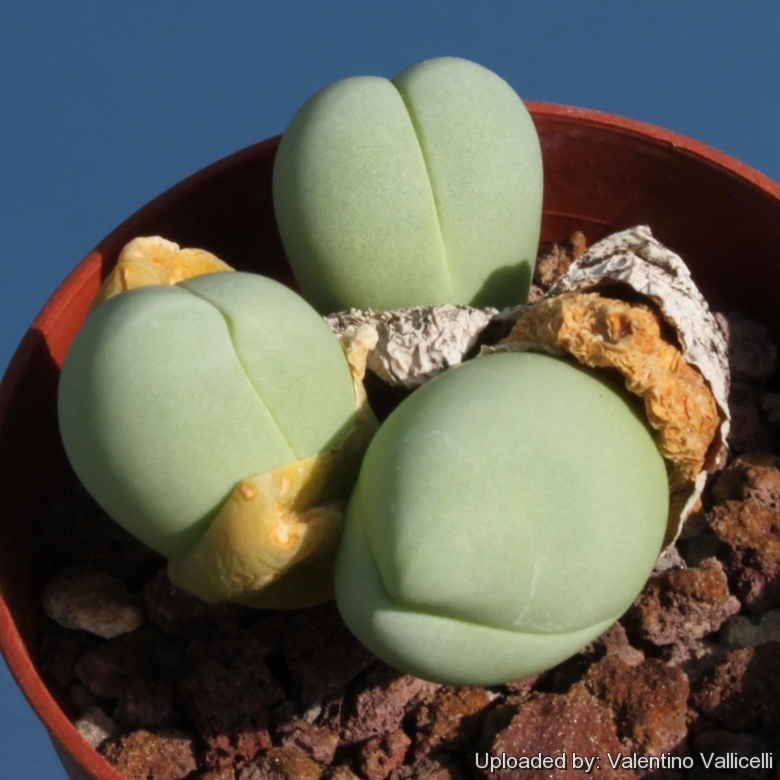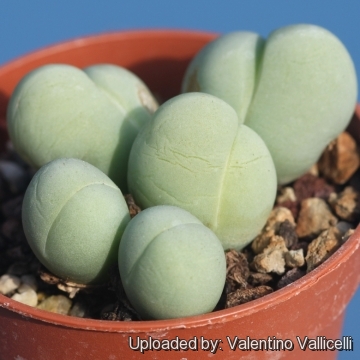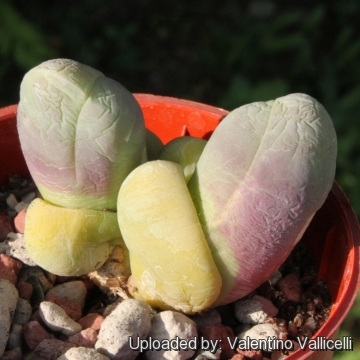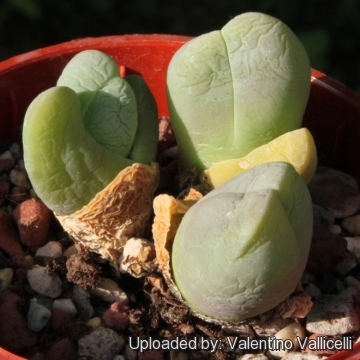Accepted Scientific Name: Gibbaeum heathii (N.E.Br.) L. Bolus
Notes Mesembryanthemum [H.M.L. Bolus] 3: 65. 1937 [14 Jan 1937] L. Bolus

Rimaria heathii (Gibbaeum heathii) Photo by: Valentino Vallicelli
Witvlakte (Big form, white flowers only)
Origin and Habitat: South African endemic. Provincial distribution Western Cape (District Ladismith, Montagu, Swellendam)
Habitat: It grows in flat, stony arid area on loamy soil with variable proportions of quartzite pebbles.
Synonyms:
See all synonyms of Gibbaeum heathii
back
Accepted name in llifle Database:Gibbaeum heathii (N.E.Br.) L. BolusNotes Mesembryanthemum [H.M.L. Bolus] 3: 65. 1937 [14 Jan 1937]Synonymy: 15
back
Common Names include:
AFRIKAANS (Afrikaans): Hondebalvygie, Hondebal
Description: Gibbaeum heathiiSN|17884]]SN|17884]] is a dwarf succulent plant forming a compact clump or mat, mostly growing above the ground, rarely sunken partially, leaves formed all over the plant. This is one of the most sought after species. It is extremely variable in form and flower and several differing form are known.
Stems: Very short, but with age, the old stems densely covered in remains of dead leaves well visible in the centre, only a little anisophyllous.
Body (paired leaves): The pair almost spherical to obovoid, fleshy but very firm to the touch, 1-5 cm, but each leaf ± semi-globose, equal to slightly unequal, joined for up to three-quarters of their length, rounded beneath; epidermis hairless, green to whitish or greyish when grown in full sun, sometimes tinged with yellow, red or purple. Old leaf remains persist around the bases of new leaves.
Flowers: (10-)20-32(-40) mm in diameter, pedicels 1-1,2 cm long, enclosed between the leaves, later the subsequent leaf-pairs, carpels mostly 7-8, rarely 6 or more than 9, petals white, cream or pale pink, filamentous staminodes none, about 140 stamens, filaments white, anthers and pollen pale yellow
Fruit: Base funnel-shaped, the 2 wings merging into the very broad wings of the stalk, thus obscuring the shape of the capsule base, top a little conically raised, often skewed because of the wedged position between the leaves, diameter approx 10 mm, 7-8, rarely 6 or 9, locules and some plants had dry papery remains on them.
Chromosome number: 2n = 18.
Bibliography: Major references and further lectures
1) Stuart Max Walters “European Garden Flora: A Manual for the Identification of Plants. Casuarinaceae to Aristolochiaceae” Cambridge University Press, 1989. page 162
2) Heidrun E. K. Hartmann “Aizoaceae F – Z” Springer, 2002 page 32
3) African Succulent Plant Society “gibbaeum heathii” The Bulletin of the African Succulent Plant Society. , Vol. 5-6 1970 page 122
4) Christoper Brickell (Editor-in-chief): RHS “A-Z Encyclopedia of Garden Plants.” Third edition. Dorling Kindersley, London 2003, ISBN 0-7513-3738-2.
5) Pauline Bohnen "More flowering plants of the Southern Cape” Still Bay Conservation Trust, 1995
6) Goldblatt, P. and Manning, J.C. 2000. “Cape Plants: A conspectus of the Cape Flora of South Africa.” Strelitzia 9. National Botanical Institute, Cape Town.
7) Raimondo, D., von Staden, L., Foden, W., Victor, J.E., Helme, N.A., Turner, R.C., Kamundi, D.A. and Manyama, P.A. 2009. “Red List of South African Plants.” Strelitzia 25. South African National Biodiversity Institute, Pretoria.
8) Vlok, J. and Schutte-Vlok, A.L. 2010. “Plants of the Klein Karoo.” Umdaus Press, Hatfield.
 Gibbaeum heathii SB799 (Collector: Steven Brack) Locality: Ockertskraal, Ladismith Division, South Africa (Gibbaeum heathii) Photo by: Valentino Vallicelli
Gibbaeum heathii SB799 (Collector: Steven Brack) Locality: Ockertskraal, Ladismith Division, South Africa (Gibbaeum heathii) Photo by: Valentino Vallicelli Rimaria heathii (Gibbaeum heathii) Photo by: Valentino Vallicelli
Rimaria heathii (Gibbaeum heathii) Photo by: Valentino Vallicelli Rimaria heathii (Gibbaeum heathii) Photo by: Valentino Vallicelli
Rimaria heathii (Gibbaeum heathii) Photo by: Valentino Vallicelli SB799 (Collector: Steven Brack) Locality: Ockertskraal, Ladismith Division, South Africa (Gibbaeum heathii) Photo by: Valentino Vallicelli
SB799 (Collector: Steven Brack) Locality: Ockertskraal, Ladismith Division, South Africa (Gibbaeum heathii) Photo by: Valentino Vallicelli Rimaria heathii (Gibbaeum heathii) Photo by: Valentino Vallicelli
Rimaria heathii (Gibbaeum heathii) Photo by: Valentino VallicelliSend a photo of this plant.The gallery now contains thousands of pictures, however it is possible to do even more. We are, of course, seeking photos of species not yet shown in the gallery but not only that, we are also looking for better pictures than those already present.
Read More... Cultivation and Propagation: It is a "winter" grower which is most active from late winter until later spring and heading for summer dormancy, and notoriously difficult to grow because it rot very easily, but Gibbaeum heathiiSN|17884]]SN|17884]], keeps going over the summer too and don’t need particular care .
Soil: It grows best in sandy-gritty soil and requires good drainage as it is prone to root rot. It can grows outdoor in sunny, dry, rock crevices (protection against winter wet is required) It can also be cultivated in alpine house, in poor, drained soil.
Fertilization: Feed it once during the growing season with a fertilizer specifically formulated for cactus and succulents (poor in nitrogen), including all micro nutrients and trace elements diluted to ½ the strength recommended on the label. It thrives in poor soils and need a limited supplies of fertilizer to avoid the plants developing excess vegetation, which is easily attacked by fungal diseases.
Watering: The Gibbaeums thrive in dry and desert regions and are able to stand extended periods of drought and require careful watering. Water minimally in summer, only when the plant starts shrivelling, water more abundantly when they are growing in the autumn and spring, but let the soil dry between soaking. Requires little water otherwise its epidermis breaks (resulting in unsightly scars). If grown in a container, bottom watering by immersing the container is recommended. It must have very dry atmosphere.
Light: It needs a bright sunny or light shade exposure in winter, but keep cool and shaded in summer.
Hardiness: It prefer a very bright situation and require a minimum temperature 5°C (But will take a light frost and is hardy down to -7° C for short periods if it is in dry soil). USDA zones 9A-11.
Uses: Container, rock garden.
Pests and diseases: It is vulnerable to mealybugs and rarely scale.
Propagation: Seed in autumn or (or rarely) cuttings. Take the cutting from a grown-up mother plant. Each cutting must contain one or more heads along with a fraction of root and permit to dry out a couple of days, lay it on the soil and insert the stem end partially into the soil. Try to keep the cutting somewhat upright so that the roots are able to grow downward. It is relatively difficult to root Gibbaeums from cuttings and generally pointless as well, so quick are they from seed.















